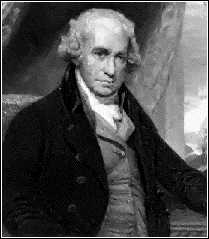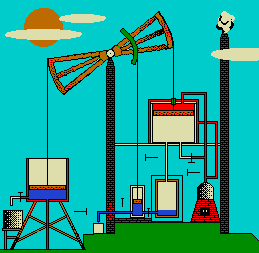 Next as
we go round the room, standing by the window is the
hypochondriac, scotish engineer know to all as James Watt, a
principle founder and very active member of the lunar society.
Next as
we go round the room, standing by the window is the
hypochondriac, scotish engineer know to all as James Watt, a
principle founder and very active member of the lunar society.James Watt
 Next as
we go round the room, standing by the window is the
hypochondriac, scotish engineer know to all as James Watt, a
principle founder and very active member of the lunar society.
Next as
we go round the room, standing by the window is the
hypochondriac, scotish engineer know to all as James Watt, a
principle founder and very active member of the lunar society.
 When he was working at Glasgow
University, repairing instruments he was given a model of a
Newcomen steam engine to repair that had been repaired before. He
realised that one of the reasons it wasn't working as that it was
so inefficient. Newcomen engines had been pumping water out of
coal mines for about the past 50 years. The engine itself was a
single cylinder piston which was filled by steam, the steam was
then condensed creating a partial vacuum in the cylinder.
Atmospheric pressure the pushes the piston down back into the
cylinder, thus creating the working stroke of an engine. The
reason the engine was is so inefficient, is because the entire
cylinder has to repeatedly be heated and cooled to above and
below 100oC having to overcome the latent heat (heat
required to change the state of a substance (e.g. liquid to gas),
without a change in the temperature of the substance) of the
system.
When he was working at Glasgow
University, repairing instruments he was given a model of a
Newcomen steam engine to repair that had been repaired before. He
realised that one of the reasons it wasn't working as that it was
so inefficient. Newcomen engines had been pumping water out of
coal mines for about the past 50 years. The engine itself was a
single cylinder piston which was filled by steam, the steam was
then condensed creating a partial vacuum in the cylinder.
Atmospheric pressure the pushes the piston down back into the
cylinder, thus creating the working stroke of an engine. The
reason the engine was is so inefficient, is because the entire
cylinder has to repeatedly be heated and cooled to above and
below 100oC having to overcome the latent heat (heat
required to change the state of a substance (e.g. liquid to gas),
without a change in the temperature of the substance) of the
system.
Watt's solution was to introduce a second cylinder in which to condense the steam, thus removing the need to heat and cool the main cylinder. This design of engine was much more efficient using only a quater of the fuel required by the Newcomen engine. When Watt's finacial backer when broke, he took his idea to Matthew Boulton. With Boulton's finical backing, and the developement by John Wilikinson of a cannon boring lathe, which for the first time allowed accurate cylinders to be bored. Watt developed a beam engine to pump the water out of mines far more efficiently. See the animation:
 The
enginge works by first, steam from the boiler is used to push
down the piston in the cylinder, lowering the beam. Secondly the
steam is redirected via a series of valves to push the piston
back up the cylinder, and so raising the beam.The clever bit is
that the steam that was used to raise the piston, is condensed in
a separate condenser allowing the engine to be kept above 100
degress. The movement of the beam is used to operate two pumps
the small pump on the same side of the boiler is used to pump the
condesed staem back into the boiler the second pump is used to
pump out water from the mine. One such engine could pump 472
gallons of water on each engine stroke.
The
enginge works by first, steam from the boiler is used to push
down the piston in the cylinder, lowering the beam. Secondly the
steam is redirected via a series of valves to push the piston
back up the cylinder, and so raising the beam.The clever bit is
that the steam that was used to raise the piston, is condensed in
a separate condenser allowing the engine to be kept above 100
degress. The movement of the beam is used to operate two pumps
the small pump on the same side of the boiler is used to pump the
condesed staem back into the boiler the second pump is used to
pump out water from the mine. One such engine could pump 472
gallons of water on each engine stroke.
In partnership with Boulton, the new design of engine was produced, Boulton and Watt had a monopoly on the production of the new engines and all the users had to pay royalities to used the engine. The royalties we're calculated from how much the company saved by using this engine rather than a team of horses, the engine was calculated to have a power of 20 horses, so the company using the engine had to pay Watt one third of the money saved by not using 20 horses per year, in total almost 500 were made. Making Boulton and Watt very rich men, in royalties alone Watt recieved £76 000.
Watt continued to develope steam engines inventing an engine to create rotary motion, and with the help of Jospeh Priestley, was the first person to publish the chemical formual of water.
Animation from http://www.geocities.com/Athens/Acropolis/6914/watte.htm.com also see the excellent BBC animation: http://www.bbc.co.uk/history/society_culture/industrialisation/launch_ani_beam_engine.shtml
image of James Watt from: http://www.tartans.com/articles/famscots/jameswatt.html